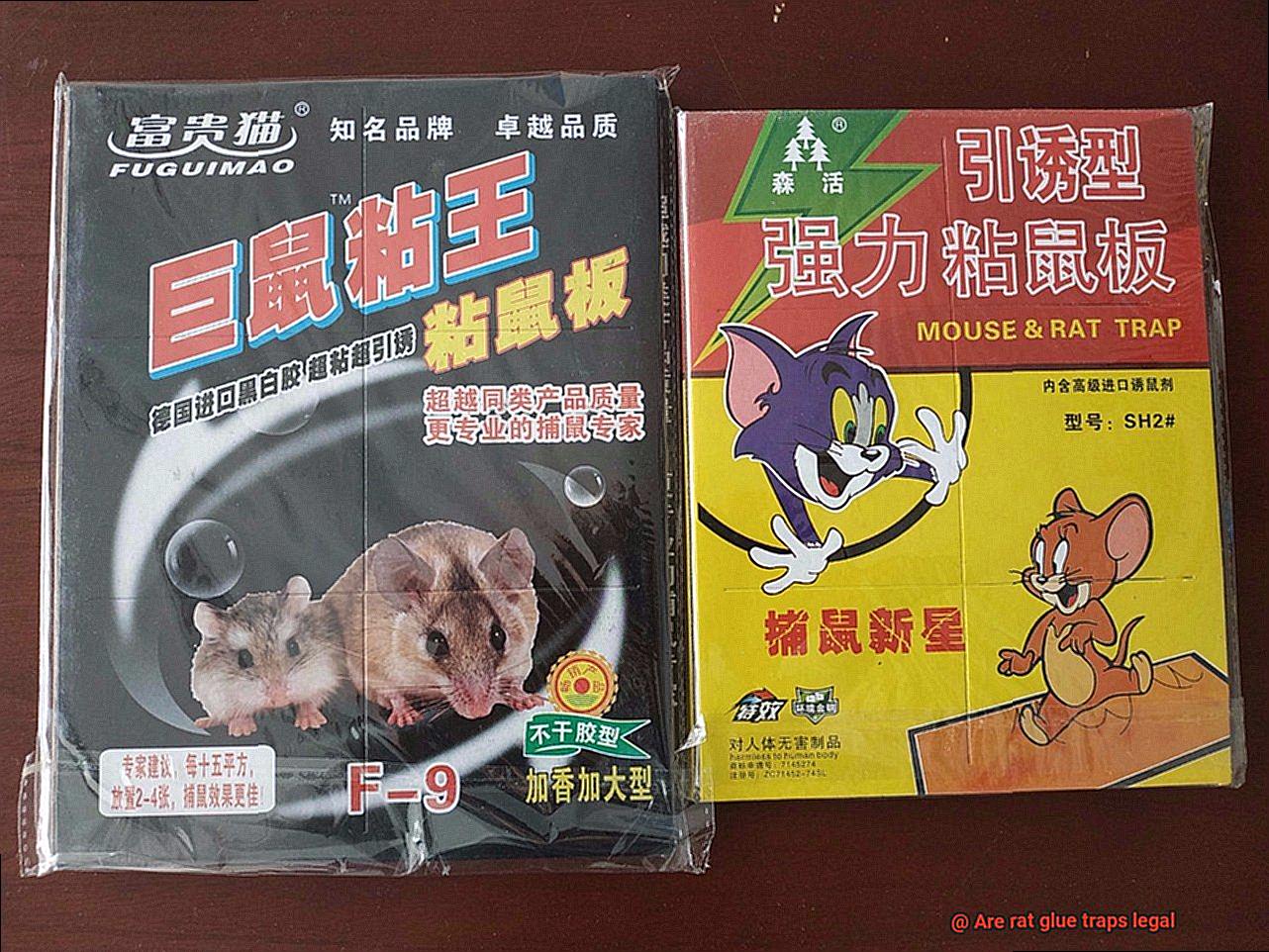Imagine this: you wake up one morning, ready to conquer the day, only to hear the pitter-patter of tiny feet scurrying around your kitchen. It’s not exactly the kind of company you were hoping for. Rats have decided to crash your cozy abode, and now you’re on a mission to evict them ASAP. As you search for effective rodent control solutions, you stumble upon the notorious rat glue trap—a sticky contraption that promises to immobilize those pesky critters.
But hold on a minute. Before you dive headfirst into this stickiness, it’s important to consider whether using such traps is actually legal. After all, nobody wants to find themselves in hot water while trying to solve a pest problem. In this blog post, we’re going to unravel the legal complexities surrounding rat glue traps and provide you with the clarity you need. We’ll explore how these traps fit into local regulations and ethical considerations so that you can make an informed decision that aligns with your values.
Now, I know legal matters might not be everyone’s cup of tea (or cheese), but trust me—this topic is more intriguing than it seems. Stick around (pun intended.) as we journey through the fascinating world of rat glue trap legality, separating fact from fiction and uncovering the ethical implications tied to their use. Whether you’re a concerned homeowner or simply curious about animal welfare, this article is here to untangle the web of regulations surrounding this controversial subject.
So buckle up and get ready because we’re about to shed some light on the age-old question: Are rat glue traps legal? Let’s dive in.
What Are Rat Glue Traps?
Contents
Imagine a world where rats no longer pose a threat, where properties are protected from damage and diseases carried by these pesky rodents. In the realm of pest control, rat glue traps have emerged as a popular choice for capturing and controlling rat populations. This comprehensive overview will delve into the purpose, utilization, and ethical considerations surrounding the use of rat glue traps, revolutionizing the way we approach rodent control.
Purpose and Use:
At the forefront of innovative pest control techniques, rat glue traps, also known as adhesive traps, are ingeniously designed to immobilize rats upon contact with their sticky adhesive surfaces. Strategically placed along pathways or in areas rats frequent, such as near food sources or concealed corners, these traps effectively capture rats by rendering them unable to move freely.
Ethical Considerations:
One compelling advantage of utilizing glue traps lies in their humane nature. Unlike poisons or harmful chemicals that endanger children, pets, and non-target animals, glue traps offer a safe alternative. However, ethical concerns arise due to potential distress and suffering experienced by trapped animals.
Recognizing these concerns, certain countries and regions have implemented regulations governing the use of rat glue traps. These regulations encompass diverse aspects such as trap size specifications, limits on trapping duration, and guidelines for environmentally responsible disposal of trapped animals. It becomes paramount for users to familiarize themselves with local laws and regulations to ensure both compliance and ethical practice.
Alternatives:
For individuals prioritizing the welfare of trapped animals, alternative methods of rodent control may be preferred. Live trapping involves capturing rats without causing harm and releasing them back into their natural habitat. Another approach centers around exclusion techniques that focus on sealing off entry points to prevent rats from infiltrating buildings or properties.
Laws and Regulations Regarding Rat Glue Traps

Imagine coming home after a long day, ready to unwind, only to find your property in disarray – chewed wires, torn furniture, and a trail of rat droppings. Annoying, right? Fear not, for rat glue traps are here to save the day. In this blog post, we will delve into the laws and regulations surrounding these sticky superheroes, ensuring that you can use them effectively and ethically.
Jurisdiction Matters:
Just like superheroes have different territories to protect, laws and regulations regarding rat glue traps vary depending on your location. It’s crucial to familiarize yourself with the specific rules in your country, state, or municipality before using these traps.
Animal Cruelty Considerations:
While rat glue traps are effective at capturing rodents, it’s vital to ensure they do not violate animal cruelty laws. Many jurisdictions have regulations in place to protect animals from unnecessary harm and suffering. These laws provide guidelines on humane treatment, even for rodents.
Labeling Requirements:
To provide users with proper information and ensure safe usage, some jurisdictions require specific labeling on rat glue trap packaging. Instructions for use and disposal, warnings about hazards, and information about alternative pest control methods may be required.
Occupational Health and Safety:
Rat glue traps pose risks not only to rats but also to humans handling them. Occupational health and safety regulations address these concerns in commercial or industrial settings, ensuring appropriate measures are taken to minimize risks for workers.

Pest Control Licensing:
In some jurisdictions, pest control professionals may need licenses or certifications. These requirements ensure that those using rat glue traps are knowledgeable about their safe and effective application.
Alternatives and Restrictions:
To promote humane practices or address concerns about animal welfare, certain jurisdictions may impose restrictions on the use of rat glue traps. Alternatives like trap-and-release programs or snap traps may be encouraged or mandated.

Animal Welfare Concerns with Rat Glue Traps
Rat glue traps, those seemingly convenient solutions to pesky rat infestations, harbor a dark secret – they come with grave animal welfare concerns. These controversial pest control methods may appear harmless, but the suffering they inflict on trapped animals is immense.
One of the primary concerns with rat glue traps lies in the excruciating pain and distress they cause to their captives. Intelligent and sentient creatures like rats experience fear and agony when ensnared in the adhesive surface. They desperately struggle to free themselves, often resulting in gruesome injuries such as torn skin, broken limbs, or even self-amputation in extreme cases. Just imagine the horror of being immobilized, slowly succumbing to exhaustion, dehydration, or starvation. It’s a cruel fate that no living being should endure.
But it’s not only rats that suffer; glue traps are indiscriminate in their targets. Birds, lizards, and small mammals also fall victim to these sticky snares. Caught in the adhesive, these unintended victims face a slow and agonizing death. This has dire consequences for protected species or beneficial animals that play crucial roles in maintaining ecosystem balance.
The ethical implications of using rat glue traps raise profound questions about our responsibility towards other living beings. Advocates for animal welfare argue that inflicting unnecessary suffering upon any creature is morally wrong and contradicts our duty to treat animals with compassion and respect. It’s vital to consider more humane alternatives that do not harm animals when seeking rodent control solutions.
Legally speaking, the use of rat glue traps varies across jurisdictions. Some countries have outright banned or restricted their usage due to animal welfare concerns. For example, Austria and Germany have enacted laws prohibiting rat glue traps. In contrast, other regions may have limited regulations or no specific laws addressing their use.
Even where rat glue traps are legal, guidelines or restrictions may exist to minimize animal suffering. Some regulations necessitate regular checks of the traps to prevent prolonged suffering. Others mandate the use of alternative methods when glue traps are deemed excessively cruel or inhumane.
Animal welfare organizations and experts vehemently discourage the use of rat glue traps due to their inherent cruelty. They advocate for the adoption of more humane and effective rodent control methods, such as integrated pest management techniques that prioritize prevention, exclusion, and non-lethal means of capturing and removing rats.
European Countries Prohibiting the Use of Rat Glue Traps
Rat glue traps, once hailed as a quick fix for rat infestations, have fallen out of favor in many European countries. The recognition of their cruelty and inhumane nature has prompted several nations to take action, prohibiting or restricting their use. Let’s delve into the reasons behind this shift.
Animal welfare concerns lie at the heart of the ban on rat glue traps. These traps subject trapped animals to extreme suffering. Caught in the adhesive, they struggle to escape, often resulting in broken bones, torn fur, and even self-mutilation. The realization of the pain and distress inflicted upon these helpless creatures has driven European countries to act.
Scientific evidence substantiates this outcry against rat glue traps. Studies have revealed the physical and psychological stress endured by animals caught in these traps, leading to a dismal welfare outcome. Such evidence highlights the imperative for more humane solutions.
Germany, Austria, and the Netherlands have taken a proactive approach to animal welfare, completely outlawing glue traps for rats. These countries acknowledge that alternative pest control methods are not only more compassionate but also more effective. Germany, for instance, emphasizes preventive measures like sealing entry points and implementing hygiene practices to discourage rodents from entering buildings. By addressing the root cause of infestations, these countries mitigate harm while ensuring lasting results.
While some European nations have yet to ban the use of rat glue traps, they have imposed strict regulations to minimize animal suffering. These regulations encompass proper labeling and instructions on trap usage to reduce harm.
To ensure effective and humane pest control practices, it is crucial for individuals and businesses across Europe to be aware of these legal restrictions and ethical considerations surrounding rat glue traps. Through increased awareness and compliance with regulations, we can protect both our homes and the welfare of innocent animals.
U.S. Laws on Rat Glue Traps
Rat glue traps have long been utilized as a means of rodent control, but their legality and ethical implications in the United States remain a topic of debate. In this article, we will delve into the legal landscape and considerations surrounding rat glue traps in the U.S.

Federal and State Regulations:
The Animal Welfare Act (AWA), a federal law, serves as a cornerstone for animal welfare standards in various contexts including research, exhibition, transport, and dealing. While it does not explicitly address glue traps, the AWA establishes general guidelines for the humane treatment of animals.
On a state level, California has taken a proactive stance by explicitly prohibiting the use of glue traps for certain animals, including rats and mice. However, it is crucial to recognize that regulations differ across states. It is advisable to consult local authorities or animal control agencies to ensure compliance with specific laws in your area.
Ethical Considerations:
Beyond legal regulations, ethical dilemmas arise when considering the use of rat glue traps. Numerous animal welfare organizations, such as PETA and the Humane Society, vehemently oppose their use due to the immense suffering inflicted upon animals.
Alternatives to Rat Glue Traps:
In response to concerns about animal cruelty, alternative methods for rodent control have gained popularity. Live traps, snap traps, and electronic traps are all considered more humane options. These alternatives allow for the capture of rodents without causing unnecessary pain or distress.
Responsible Use:
Even if rat glue traps are legally permitted in your jurisdiction, it is essential to prioritize animal welfare. This entails regularly checking and removing trapped animals to prevent prolonged suffering. Moreover, it is worth noting that employing alternative methods can be equally effective in controlling rodent populations while preserving animal well-being.
Guidelines for Responsible Use of Rat Glue Traps
Rat glue traps – a contentious tool in the battle against rodents. While opinions may differ, it is crucial to approach their use responsibly, striking a balance between effective pest control and the welfare of animals. In this article, we will delve into the guidelines for responsible use of rat glue traps, ensuring that our actions prioritize compassion and effectiveness.
Last Resort: Exhaust Non-Lethal Alternatives
Before resorting to rat glue traps, exhaust all non-lethal alternatives. Seal entry points, remove food sources, and utilize live traps. Let us give these little critters a chance to find their way out peacefully.
Strategic Placement: Maximize Effectiveness, Minimize Suffering
To capture rats quickly and with minimal distress, place the traps strategically. Along walls or near known access points are ideal spots. By doing so, we increase the likelihood of successful captures while reducing unnecessary suffering.
Regular Monitoring: Act Swiftly, Minimize Distress
Frequent monitoring of the traps is crucial. If a rat becomes ensnared in the glue trap, act swiftly to minimize its distress. Gently free the rodent using vegetable oil or a similar substance. Our aim is humane treatment at all times.
Humane Disposal: Compassion at the End of the Journey
Once a rat is successfully captured, it is essential to dispose of it humanely. Release it far away from human dwellings in a safe location or use euthanasia methods approved by local regulations. Let us ensure that their journey ends with compassion.
Safety First: Protect Children and Pets
Keep rat glue traps out of reach of children and pets. Accidental exposure or harm caused by these traps is unacceptable. Safety should be our top priority at all times.
9-Xu8PNvkKA” >
Conclusion
In conclusion, the legality of rat glue traps is a complex matter that varies across jurisdictions. Some countries have taken a strong stance against these traps, banning or heavily restricting their use due to concerns about animal welfare. In contrast, other regions may have limited regulations or no specific laws addressing their use at all. It is absolutely crucial for individuals and businesses to thoroughly familiarize themselves with the laws and regulations in their respective locations before considering the use of these traps.
However, legalities are not the only factor to consider when it comes to rat glue traps. Ethical considerations also come into play, as animal welfare organizations and experts strongly discourage their use due to the immense suffering they inflict on trapped animals. The images of struggling rodents stuck in adhesive are truly heart-wrenching. It is important for us to reflect on our own values and consider more humane alternatives that do not cause unnecessary pain or distress.
Thankfully, there are alternative methods available for those who prioritize the welfare of trapped animals. Live trapping or exclusion techniques can be favored by individuals seeking rodent control solutions that minimize harm. These methods allow for the capture and removal of rats without subjecting them to agonizing pain.
Regardless of legalities and ethics, responsible use of rat glue traps should always be practiced. This means strategically placing the traps, regularly monitoring them, and ensuring humane disposal of any trapped animals. Additionally, safety precautions must be taken to protect children and pets from accidental exposure or harm caused by these traps.
By carefully considering both legal requirements and ethical considerations, individuals can make informed decisions about whether to use rat glue traps or explore alternative methods for rodent control that prioritize animal welfare.






